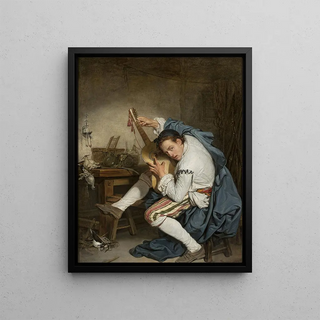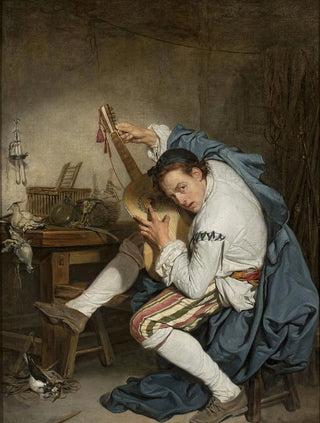Art print | Guitarist - Jean-Baptiste Greuze


View from behind

Frame (optional)
In the world of art, some works transcend time and manage to capture the very essence of humanity. "Guitarist" by Jean-Baptiste Greuze is one of these creations. This canvas, created in the 18th century, evokes not only the technical virtuosity of the artist but also a deep emotional sensitivity. The guitarist's gaze, lost in his melody, invites us to share a moment of intimacy, where music becomes a universal language. The art print Guitarist - Jean-Baptiste Greuze allows us to rediscover this iconic piece, whose beauty lies in its simplicity and depth.
Style and uniqueness of the work
Greuze's style is distinguished by its poignant realism and its ability to capture human emotions. In "Guitarist," the soft light illuminating the musician's face creates an intimate, almost contemplative atmosphere. The artist uses warm tones and delicate nuances to bring his subject to life, while maintaining a certain sobriety. The composition, focused on the character, immediately draws the eye and invites careful observation of the details. The guitarist's hands, skillfully rendered, seem to vibrate to the rhythm of the music, while his expression reveals a deep connection with the art he practices. This work is a true ode to passion and creativity, where each brushstroke testifies to Greuze's skill.
The artist and his influence
Jean-Baptiste Greuze, an emblematic figure of the 18th century, marked art history with his innovative approach to portraiture and genre painting. Raised in a rich artistic context, he established himself as a master of realism by incorporating narrative elements into his works. Greuze influenced many artists, both through his technique and his vision of art as a means of expressing emotions. His work paved the way for later movements, notably Romanticism, where the expression of feelings becomes paramount. Through "Guitarist," he reminds us that art is not limited to visual representation but is also a vehicle for emotions and reflections on the human condition.
A wall decoration of

Matte finish

View from behind

Frame (optional)
In the world of art, some works transcend time and manage to capture the very essence of humanity. "Guitarist" by Jean-Baptiste Greuze is one of these creations. This canvas, created in the 18th century, evokes not only the technical virtuosity of the artist but also a deep emotional sensitivity. The guitarist's gaze, lost in his melody, invites us to share a moment of intimacy, where music becomes a universal language. The art print Guitarist - Jean-Baptiste Greuze allows us to rediscover this iconic piece, whose beauty lies in its simplicity and depth.
Style and uniqueness of the work
Greuze's style is distinguished by its poignant realism and its ability to capture human emotions. In "Guitarist," the soft light illuminating the musician's face creates an intimate, almost contemplative atmosphere. The artist uses warm tones and delicate nuances to bring his subject to life, while maintaining a certain sobriety. The composition, focused on the character, immediately draws the eye and invites careful observation of the details. The guitarist's hands, skillfully rendered, seem to vibrate to the rhythm of the music, while his expression reveals a deep connection with the art he practices. This work is a true ode to passion and creativity, where each brushstroke testifies to Greuze's skill.
The artist and his influence
Jean-Baptiste Greuze, an emblematic figure of the 18th century, marked art history with his innovative approach to portraiture and genre painting. Raised in a rich artistic context, he established himself as a master of realism by incorporating narrative elements into his works. Greuze influenced many artists, both through his technique and his vision of art as a means of expressing emotions. His work paved the way for later movements, notably Romanticism, where the expression of feelings becomes paramount. Through "Guitarist," he reminds us that art is not limited to visual representation but is also a vehicle for emotions and reflections on the human condition.
A wall decoration of






